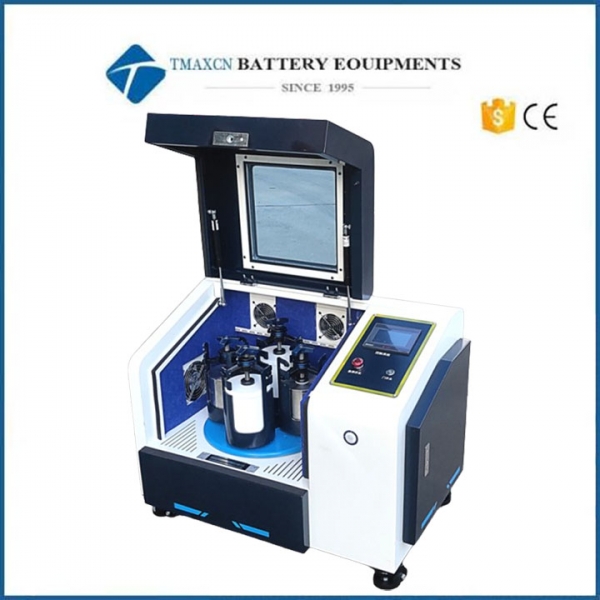Site de Blog
Linha de Máquinas de Fabricação de Células Cilíndricas Automáticas
fabricação e equipamento de laboratórios de bateria li-ion 18650
fluxograma de célula de moeda de íon de lítio e lista de máquinas
fabricação e equipamento de laboratórios de baterias com bateria de íon de lítio
dez 2016 aceitação de fábrica do cliente nos EUA da máquina de empilhamento automático
Contate-nos
- Se você tiver dúvidas, entre em contato conosco, todas as perguntas serão respondidas
- Email : David@tmaxcn.com
- Email : Davidtmaxcn@gmail.com
- Adicionar : No. 39, Xinchang Road, Xinyang, Haicang Dist., Xiamen, Fujian, China (Mainland)
produtos quentes
Xiamen Tmax Battery Equipments Limited was set up as a manufacturer in 1995, dealing with lithium battery equipments, technology, etc. We have total manufacturing facilities of around 200000 square foot and more than 230 staff. Owning a group of experie-nced engineers and staffs, we can bring you not only reliable products and technology, but also excellent services and real value you will expect and enjoy.
A planetary ball mill is a highenergy grinding device widely used in materials science, chemistry, and metallurgy for size reduction, mixing, and mechanical alloying. It operates on the principle of planetary motion, where grinding jars rotate around their own axes while simultaneously revolving around a central axis. This dual rotation generates high centrifugal forces that enable efficient and precise material processing.
In this article, we will explore the design, functionalities, advantages, challenges, and applications of planetary ball mills.
●Design and Operation of Planetary Ball Mills
1. Key Components
Grinding Jars: Containers where materials are placed along with grinding media (e.g., balls).
Grinding Media: Typically made of steel, tungsten carbide, zirconia, or ceramic.
Sun Disk: The central rotating disk that drives the planetary motion.
Planetary Disks: Rotating disks attached to the sun disk, holding the grinding jars.
2. Operation Principle
The grinding jars rotate around their own axes while simultaneously revolving around the central sun disk.
This dual motion creates highenergy impacts between the grinding media and the material, resulting in fine particle sizes and uniform mixing.
●Functionalities of Planetary Ball Mills
1. Size Reduction:
Breaks down solid materials into fine powders, often achieving micron or even nanoscale particles.
2. Mechanical Alloying:
Produces alloys by mechanically deforming and mixing different metallic powders under highenergy impacts.
3. Homogenization:
Mixes heterogeneous materials into a uniform composition.
4. Mechanochemical Synthesis:
Facilitates chemical reactions through mechanical energy, enabling the synthesis of new materials.
●Advantages of Planetary Ball Mills
1. HighEnergy Grinding:
Achieves finer particle sizes compared to traditional grinding methods.
2. Versatility:
Suitable for processing a wide range of materials, including metals, ceramics, polymers, and composites.
3. Precision Control:
Allows adjustment of rotational speed, grinding time, and jar orientation for optimal results.
4. Efficiency:
Processes materials faster and more uniformly than conventional mills.
5. Scalability:
Available in laboratoryscale and industrialscale models to meet diverse needs.
1. Wear and Contamination:
Highenergy impacts can cause wear on grinding jars and media, leading to contamination of the processed material.
2. Heat Generation:
Friction during grinding can generate heat, potentially affecting thermally sensitive materials.
3. Noise and Vibration:
Operates at high speeds, producing significant noise and vibration.
4. Complexity:
Requires careful parameter optimization to achieve desired results.
5. Cost:
Highquality planetary ball mills and grinding media can be expensive.
●Innovations in Planetary Ball Mills
To address these challenges and enhance performance, manufacturers are incorporating advanced technologies:
1. Advanced Materials:
Use of wearresistant coatings and highperformance ceramics for grinding jars and media.
2. Temperature Control:
Integrated cooling systems to manage heat during long grinding processes.
3. Automation:
Programmable controls for precise parameter settings and unattended operation.
4. Silencing Features:
Noisereducing enclosures to minimize operational disturbances.
5. Smart Monitoring:
Sensors and data analytics tools for realtime monitoring of grinding conditions.
●Applications of Planetary Ball Mills
Planetary ball mills are used across various industries and research fields:
1. Materials Science:
Synthesis of nanomaterials, metal alloys, and composite materials.
2. Pharmaceuticals:
Preparation of fine powders for drug formulations and active pharmaceutical ingredients (APIs).
3. Ceramics:
Production of homogeneous ceramic powders for sintering and coating applications.
4. Mining and Metallurgy:
Size reduction of ores and minerals for analysis and processing.
5. Chemistry:
Mechanochemical synthesis of novel compounds and catalysts.
●The Future of Planetary Ball Mills
As material science continues to evolve, planetary ball mills will play an increasingly important role in advancing technology. Key trends shaping the future include:
1. Increased Automation:
Fully autonomous systems will optimize grinding parameters and reduce human intervention.
2. Customization Options:
Modular designs will allow users to tailor mills for specific materials and applications.
3. Focus on Sustainability:
Ecofriendly practices and energyefficient designs will become standard.
4. Integration with Advanced Technologies:
IoTenabled mills will connect to smart labs for realtime data analysis and process optimization.
5. Development of New Materials:
Advances in grinding media and jar materials will enable processing of even harder or more reactive substances.
●Conclusion
Planetary ball mills are indispensable tools for material processing, offering unparalleled precision and versatility in size reduction, mixing, and mechanochemical synthesis. Their ability to handle a wide range of materials makes them essential in research and industry alike.
What excites you most about the role of planetary ball mills in advancing material science? Share your thoughts below! Together, let’s explore how these powerful tools can shape the future of material innovation.
 ru
ru English
English











 +86 13174506016
+86 13174506016 David@tmaxcn.com
David@tmaxcn.com

